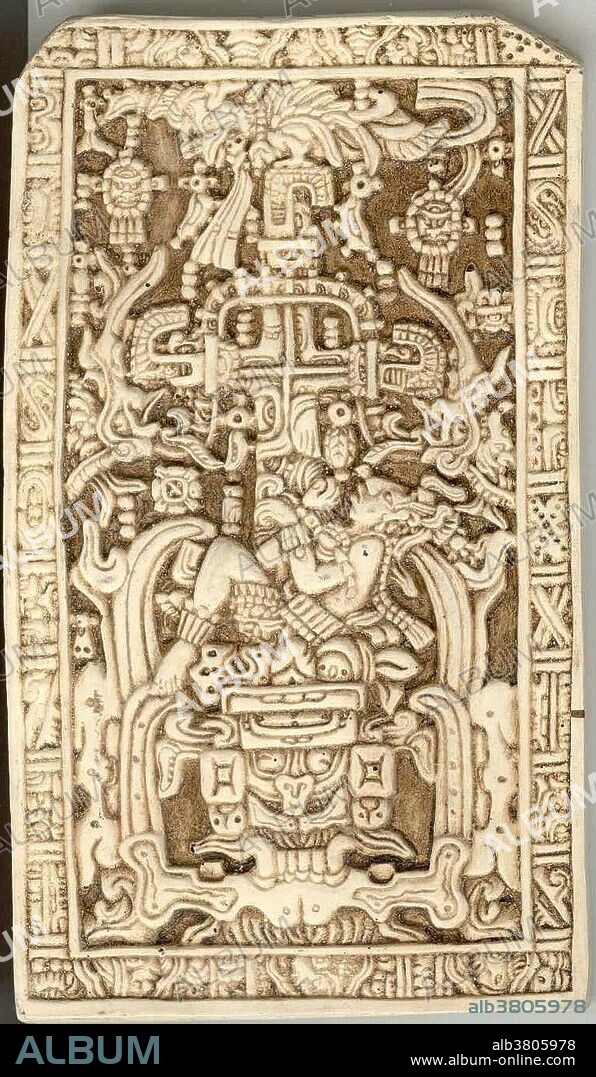alb3805978
Sarcophagus Lid, Tomb of Pakal, 7th Century

|
Añadir a otro lightbox |
|
Añadir a otro lightbox |



¿Ya tienes cuenta? Iniciar sesión
¿No tienes cuenta? Regístrate
Compra esta imagen.
Selecciona el uso:

Título:
Sarcophagus Lid, Tomb of Pakal, 7th Century
Descripción:
Traducción automática: K'inich Janaab' Pakal (marzo de 603 - agosto de 683) fue gobernante de la entidad política maya de Palenque en el período Clásico Tardío de la cronología mesoamericana precolombina. Durante su reinado de 68 años fue responsable de la construcción o ampliación de algunas de las inscripciones y la arquitectura monumental más notables que se conservan en Palenque. La gran tapa de piedra tallada del sarcófago del Templo de las Inscripciones es una pieza única del arte maya clásico. Alrededor de los bordes de la tapa hay una banda con signos cosmológicos del sol, la luna y la estrella, así como las cabezas de seis nobles nombrados. La imagen central es la de un árbol del mundo cruciforme. Debajo de Pakal hay una de las cabezas de una serpiente celestial de dos cabezas. Tanto el rey como la cabeza de serpiente sobre la que reposa están enmarcados por las fauces abiertas de una serpiente funeraria, un dispositivo iconográfico común para señalar la entrada o la residencia en el reino de los muertos. El propio rey lleva los atributos del dios tonsurado del maíz y se lo muestra en una postura peculiar que puede denotar renacimiento. La interpretación de la tapa ha suscitado controversia
K'inich Janaab' Pakal (March 603 - August 683) was ruler of the Maya polity of Palenque in the Late Classic period of pre-Columbian Mesoamerican chronology. During his 68 year reign he was responsible for the construction or extension of some of Palenque's most notable surviving inscriptions and monumental architecture. The large carved stone sarcophagus lid in the Temple of Inscriptions is a unique piece of Classic Maya art. Around the edges of the lid is a band with cosmological signs for sun, moon, and star, as well as the heads of six named noblemen. The central image is that of a cruciform world tree. Beneath Pakal is one of the heads of a celestial two headed serpent. Both the king and the serpent head on which he rests are framed by the open jaws of a funerary serpent, a common iconographic device for signaling entrance into, or residence in, the realm(s) of the dead. The king himself wears the attributes of the Tonsured maize god, and is shown in a peculiar posture that may denote rebirth. Interpretation of the lid has raised controversy.
Personas:
Crédito:
Album / Science Source / New York Public Library
Autorizaciones:
Modelo: No - Propiedad: No
¿Preguntas relacionadas con los derechos?
¿Preguntas relacionadas con los derechos?
Tamaño imagen:
762 x 1310 px | 2.9 MB
Tamaño impresión:
6.5 x 11.1 cm | 2.5 x 4.4 in (300 dpi)
Palabras clave:
AMERICA CENTRAL • ARTE PRIMITIVO • ARTE • CIVILIZACION ANTIGUA • CIVILIZACION MAYA • CONTROVERTIDO • CULTURA ANTIGUA • FAMOSA • FAMOSO • GOBERNANTE • HISTORIA • HISTORICO • IMPORTANTE • LEGENDARIO • MAYA • MAYAN • MAYAS • MESOAMERICA • OBRA DE ARTE • REY • S. VII • SIGLO VII • TALLA • TUMBA
 Pinterest
Pinterest Twitter
Twitter Facebook
Facebook Copiar enlace
Copiar enlace Email
Email
